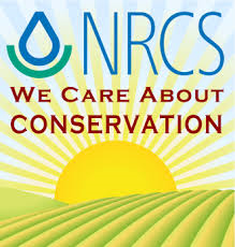Enrique Garay - Soil Technician
Cody Richey - Soil Conservationist
Chantel Davis - District Conservationist
Cody Richey - Soil Conservationist
Chantel Davis - District Conservationist
Our Mission:
To provide leadership in a partnership effort to help people conserve, improve, and sustain our natural resources and environment…
Our Vision:
Harmony between people and the land..
Our History:
NRCS draws on a tradition of principles in working with private NRCS landowners that is as relevant today as when it was a dream to Hugh Hammond Bennett in the late 1920s and early 1930s.
A career soil scientist in USDA, Bennett became convinced that soil erosion was a national menace and that its solution lay in tailoring conservation practices to fit the capability of the land and the desires of landowners. Simple solutions for all situations would be fruitless.
The crops, the land and the climate were so diverse that specialists in agronomy, forestry, soil science, biology, engineering, and soil sciences contributed to conservation methods. They worked with farmers to find solutions that benefited the land and fulfilled the landowners’ aspirations.
In 1933, the Soil Erosion Service, predecessor to the Soil Conservation Service and NRCS, began working with farmers in the Coon Creek watershed of southwestern Wisconsin to transform the square, eroding fields into what one sees today–a
conservation showplace of contouring, strip cropping, terracing, and wise land use that benefits the soil, air, water, as well as the plant, animal, and human life of the whole watershed.
The carpeting of the land with soil conservation works nationwide was hastened with the passage of the Soil Conservation Act in April of 1935. Recognition of the first conservation district, bounded by the Brown Creek watershed in North Carolina, on August 4, 1937, established a method of the Service to assist farmers in the conservation districts. Locally elected citizens established priorities and plans for districts’ work.

